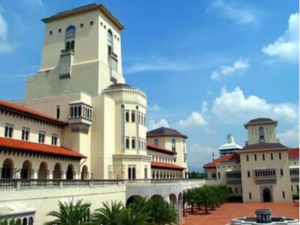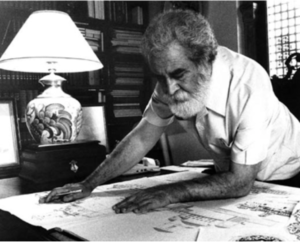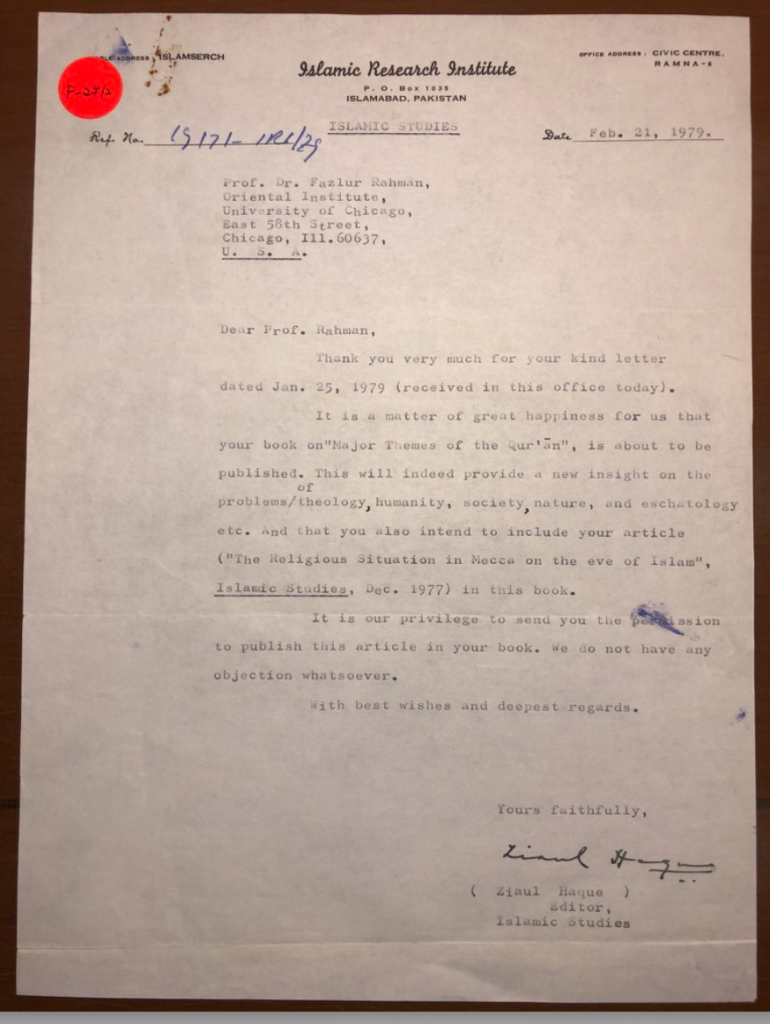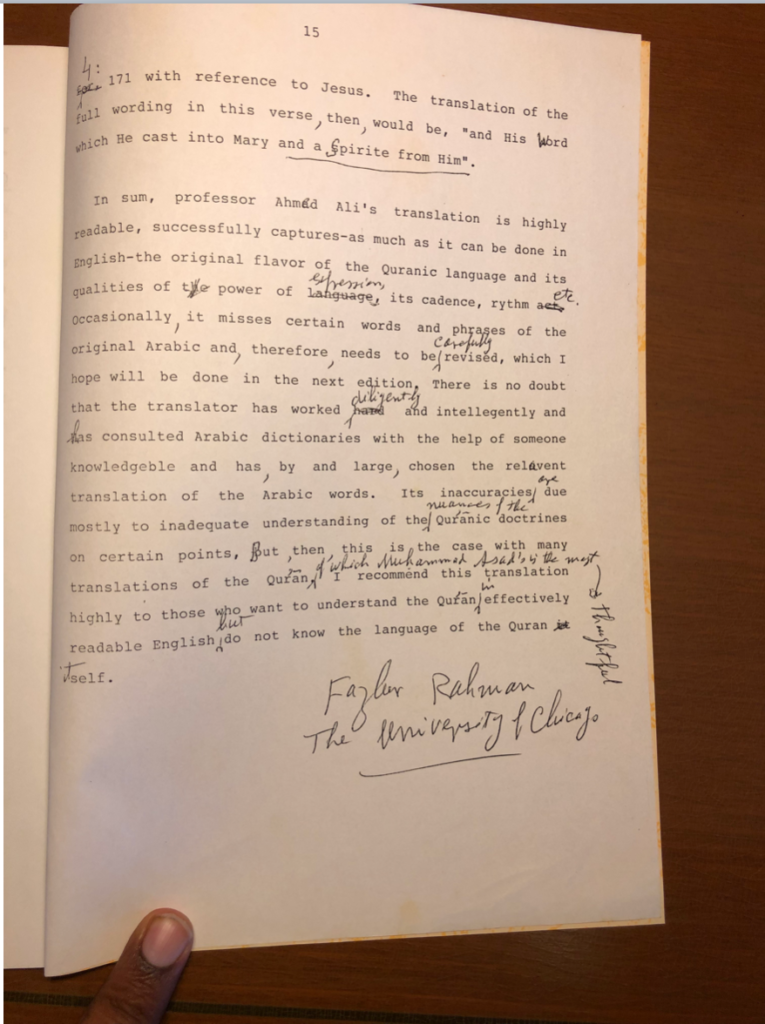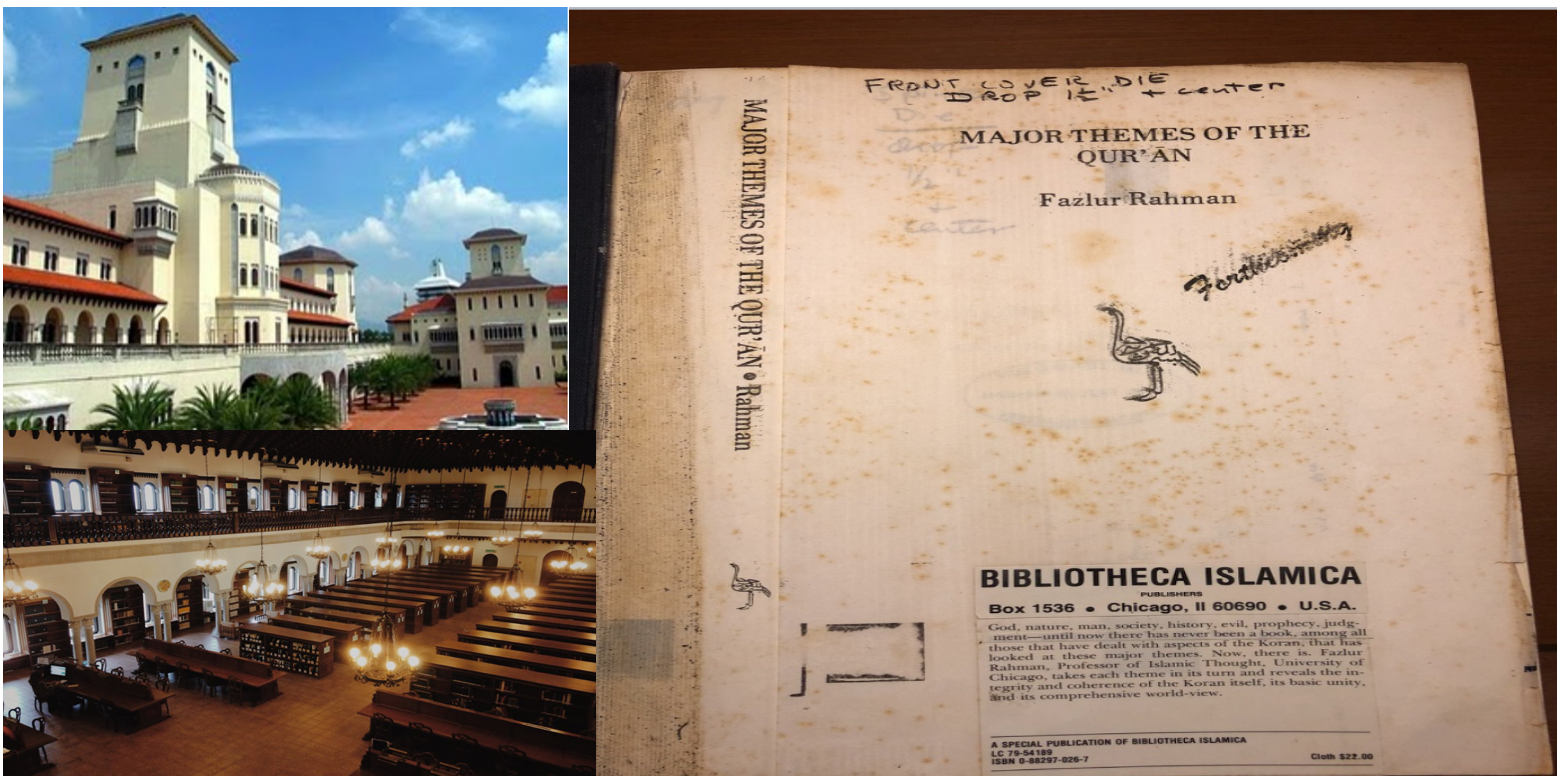
This summer I had the opportunity to visit the library at the International Institute of Islamic Thought and Civilization, or to cite its better known acronym, ISTAC, in Kuala Lumpur, Malaysia.[1] The ISTAC building stands as a “castle-like” structure on top of a hill in one of Kuala Lumpur’s posh areas, where many diplomats and politicians live.[2]
The library and the building as a whole was the brainchild of the famous Malay thinker Syed Muhammad Naquib al-Attas, who designed and oversaw every detail. Al-Attas, one of “the most celebrated Muslim thinkers in the contemporary Malay world” and famously known for his work Islam and Secularism,[3] modeled the building after the Alhambra in Spain and sought to create a world-class library that would rival top-tier research libraries in Europe and the US. He spent lavishly on acquiring manuscript collections of Western scholars with whom he studied or encountered, such as Bertold Spuler[4] and Fazlur Rahman.[5] Through his efforts, al-Attas was able to make the ISTAC library among the most important Islamic collections in all of Southeast Asia.[6]

The Fazlur Rahman Collection at ISTAC
During my stay at the ISTAC Library, I scanned through the Arabic manuscripts but was drawn time and time again to Fazlur Rahman’s collection, which included personal letters that dealt with everything from his salary changes to correspondences with other scholars. The collection seems to be relatively unknown, as a recent book on the scholar The Theological Thought of Fazlur Rahman does not reference it.[7] Rahman, in particular, has had an important influence on Islam in Southeast Asia, so it is no wonder al-Attas would be interested in purchasing his collection. In his comparison of the influence of Isma‘il al-Faruqi, Fazlur Rahman and Seyyed Hossein Nasr on Southeast Asia, Osman Bakar (who is now the Director of ISTAC) states that “Rahman is currently the best known and most influential of the three scholars in Indonesia” even though Nasr’s influence is growing and al-Faruqi’s impact is greater in Malaysia.[8]
Intellectual Foundations of Major Themes of the Qur’an
As a scholar of the Qur’an and its exegesis (tafsir), I was interested in the intellectual foundations of Rahman’s Major Themes of the Qur’an, which has been translated into numerous languages and has had a strong influence on academic study of the Qur’an in the West.[9][10] Rahman’s Major Themes of the Qur’an is part of larger modern trend of thematic Qur’anic exegesis (al-tafsir al-mawdu‘i).[11] Instead of analyzing Qur’anic verses one-by-one or in sections, as classical tafsir do, these works are interested in particular themes of the Qur’an.[12] In regards to Major Themes, Tamara Sonn explains that, “In order to make Islam relevant to its specific circumstances, [Rahman] believed each generation must go beyond traditional or literalist interpretations of the Qurʾān to an understanding of its spirit.” Rahman advocated for a “holistic understanding of the Qur’an,” one that was compatible with “modern” life.[13] Similarly, Ebrahim Moosa, in his preface to the second edition of the book, argues that Rahman “saw Major Themes as the groundwork for a new theology, which was rooted in the ethos of the Qur’an.”[14]

Lack of Classical Tafsir in the Collection
Specifically, I was interested to see what classical works may have influenced Rahman in writing his famous commentary; however, I was surprised to find that his personal collection did not include any books of tafsir or Qur’anic sciences and contained only a few copied pages from the tafsir of al-Qurtubi (d. 671/1273). In certain ways, the finding should not come as a surprise since Rahman famously categorized classical tafsir as “atomistic” and argued that it missed larger themes and structures.[15] Alparslan Açıkgenç explains that in the University of Chicago, “[Rahman] achieved, for the first time, his longstanding goal of teaching the Qurʾān without the use of any of the traditional commentaries used in classical Islamic education, applying his own Qurʾānic hermeneutics.”[16]
“Specifically, I was interested to see what classical works may have influenced Rahman in writing his famous commentary; however, I was surprised to find that his personal collection did not include any books of tafsir or Qur’anic sciences and contained only a few copied pages from the tafsir of al-Qurtubi (d. 671/1273). In certain ways, the finding should not come as a surprise since…”
Nonetheless, the collection did include other writings that were important to the publication of Major Themes such as the final proofs of the book and correspondences with editors of journals from whom he sought permission to include previously published works.[17]
A 1970 Sermon at University of Chicago and Taqwa
One particular document caught my attention: a sermon (khutba) entitled “Moral Tension and Human Conduct in the Qur’an” delivered at the University of Chicago Rockefeller Memorial Chapel on November 8, 1970. The date signals that Rahman was only at the University for a year and was already beginning to contribute to its religious life.[18] The sermon was written on a typewriter and must have been a final draft since there are no crossed out characters. After the recitation of several Qur’anic verses, Rahman begins the khutba explaining what he is about to do, suggesting that there were non-Muslims in the audience observing his speech. Moreover, the way he describes the service, with a second khutba delivered in Arabic, alludes to a Hanafi prayer indicating Rahman’s South Asian background, which was most likely shared by members of the audience.

Rahman’s main point in the sermon is that “moral tension” is a natural part of life and that the Qur’an is “absolutely emphatic that the tensions that have been created in man be kept alive.” To make his point, Rahman cites the story of Adam and Satan which demonstrates that the tension between good and evil starts from the beginning.[19] Man and Satan are thus “coevals” in that they represent different sides of the tensions. For Rahman, acting rightly is connected to knowledge, to the fact that “man must know.” However, knowledge is something that should not be only “had” but rather is tied to perception and is “the fruit of struggle, of an intellectual struggle.” In his knowledge paradigm, intellectual and moral struggles are intimately tied together and build off one another.
This “moral tension” and “intellectual struggle” are connected to the key Qur’anic concept of taqwa, a word that Rahman would continue to define throughout the remainder of his life. Rahman is critical of the term being translated as “fear” and simply about “no” or negation. Rather the term is about getting to “yes” and has a forward-looking dimension. Once one says “no” to certain elements then they have the ability to say “yes” to others. As Rahman explains, when you “exercise your choice under a clear, fully aware sense of responsibility, then God comes and meets you there.” Taqwa is essentially about maintaining a balance in the moral tension and keeping the intellectual struggle in the right direction.
In Major Themes, we see a development of Rahman’s understanding of taqwa when he writes that taqwa is an “inner torch” that helps one “discern between right and wrong”.[20] As he further elaborates, “This unique balance of integrative moral action is what the Qur’ān terms taqwa, perhaps the most important single term in the Qur’ān…Taqwa, then, in the context of our argument, means to be squarely anchored within the moral tensions, the ‘limits of God,’ and not to ‘transgress’ or violate the balance of those tensions or limits.”[21] Here Rahman uses the terms “moral tension” and “balance,” echoing his khutba composed ten years earlier. In his later article “Some Key Ethical Concepts in the Qur’an,” Rahman once again returns to defining taqwa and articulates that it is equally comprised of both faith (iman) and surrender (islam).[22] Taqwa ultimately has an inner and positive dimension that allows a person “to correctly examine himself and to see the right from the wrong.”[23]

For a khutba, the language is dense and complicated; there is no doubt that it would have gone over the heads of many in the congregation. Nonetheless, you can feel Rahman’s sincerity and confessionalism throughout the speech. You can tell that he is addressing other Muslims and encouraging them to have a more complex understanding of their faith, connected to a moral and intellectual understanding of the Qur’an. Rahman’s confessionalism may be most clearly seen at the end of his sermon, where he concludes with the prayer: “O Lord, let us see things as they are, let us have a genuine and true knowledge of things, and having got this knowledge, give us the capacity, the strength and the power to go ahead with this struggle and come into your kingdom of mercy. Amen.”
Rahman’s Engagement in Confessional Settings
In summary, the manuscript both confirmed and modified my existing views on Rahman. First, the sermon further establishes that Rahman was deeply connected to and motivated by the Qur’an.[24] He was drawn to its moral debates and was interested in learning how it was connected to modern life and the average believer. Rahman does not cite any other external sources, no Qur’anic commentaries for instance, and seems to rely on his own interpretation and insights. Moreover, his writing takes a more philosophical tone, with long sentences and complex moral claims.[25] Accordingly, much of his scholarship continues to be influential among intellectuals but not necessarily the masses. However, the sermon did change my view of Rahman as an ivory tower figure who wrote and spoke solely from his position as a professor. As somebody who never met Rahman and only knew him through his writings, I was under the impression that he was a theoretician and interested in larger ideas of reform and modernism. Here, however, we see Rahman in a chapel addressing Muslims and non-Muslims regarding spirituality, faith and practice. His sincerity towards acquiring knowledge and entering God’s mercy is evident.
“Accordingly, much of his scholarship continues to be influential among intellectuals but not necessarily the masses. However, the sermon did change my view of Rahman as an ivory tower figure who wrote and spoke solely from his position as professor.”
In conclusion, the trip to ISTAC and the chance to examine Rahman’s collection allowed me to see the interconnected ideas across regions and cultures. I would never have thought that a University of Chicago professor’s private collection would be in Southeast Asia, preserved in this remarkable library. It also made me realize that we cannot continue to marginalize the contributions of Southeast Asia to the study of Islam. Southeast Asia has its own history and culture of Islamic studies that must be appreciated on its own terms and inform our understanding of Islam as a whole.[26]
Younus Y. Mirza is a Visiting Researcher at Georgetown University and Scholar in Residence at Shenandoah University where he directs the Barzinji Global Exchange Project. To learn more about his scholarship, teaching and speaking, please visit his website http://dryounusmirza.com
[1] For a discussion of the term “Islamic Civilization” in Malaysia see Carl Ernst, “The Perils of Civilizational Islam in Malaysia,” in Rethinking Islamic Studies: From Orientalism to Cosmopolitanism, eds. Carl W. Ernst and Richard C. Martin (Columbia, S.C.: University of South Carolina Press, 2010), 266-280.
[2] Witkam’s full description is “High on a hill in Taman Duta, Kuala Lumpur, Malaysia, with a commanding view over the surroundings, overlooking an affluent neighbourhood of villas set in lush gardens, stands a castle-like compound, built as if inspired by an Orientalist fairy tale”;Jan Just Witkam, “The Former ISTAC Library in Kuala Lumpur and Its Islamic Manuscripts. Travel Notes,” Journal of Islamic Manuscripts 8 (2017): 282;For more on the relationship between Malay intellectuals, politics and ISTAC see Mona Abaza, “Intellectuals, Power and Islam in Malaysia: S.N. al-Attas or the Beacon on the Crest of a Hill,” Archipel 58 (1999): 189–217. For more on Islamic Studies in Malaysia more generally, see Ibrahim Abu Bakar, “A History of Islamic Studies in Malaysia,” in Oriente Moderno 19, no. 2 (2000): 371-393.
[3] Khalif Muammar, “Syed Muhammad Naquib al-Attas,” Oxford Islamic Studies Online (New York, N.Y.: Oxford University Press, 2019).
[4] For more on his collection, see Ernest Wolf-Gazo, “On the Bertold Spuler Collection Found in the Library of ISTAC,” al-Shajarah: Journal of the International Institute of Islamic Thought and Civilization (ISTAC) 2, no. 2 (1997): 291-300.
[5] For more on how al-Attas acquired his collection see Witkam.
[6] For more on the content of the collection, see Mohd Zaid Abd Rahman, “The Library of the International Institute of Islamic Thought and Civilization (ISTAC)”, Library Review 54, no. 1 (2005): 59-67; Sharifah Shifa Al-Attas and Syed Muhammad Naquib al-Attas, ISTAC illuminated: a Pictorial Tour of the International Institute of Islamic Thought and Civilization (ISTAC) Kuala Lumpur (Kuala Lumpur: International Institute of Islamic Thought and Civilization (ISTAC), 1998).
[7] Ahad Ahmed, The Theological Thought of Fazlur Rahman (Kuala Lumpur: Islamic Book Trust, 2017).
[8] Osman Bakar, “The Intellectual Impact of American Muslim Scholars on the Muslim World, with Special Reference to Southeast Asia,” in Muslims in the United States: Identity, Influence, Innovation, ed. Philippa Strum (Washington D.C.; Woodrow Wilson International Center for Scholars, 2005). See also Bakar’s “Competing Visions of Islam in Southeast Asia: American Muslim Scholarship as a Shaping Factor” which also appears in the same volume. For more on Rahman’s influence in Indonesia see Ahmad Najib Burhani, “Transmission of Islamic Reform from the United States to Indonesia,” Indonesia and the Malay World 41, (2013): 29-47.
[9] Ahmed considers Major Themes of the Qur’an to be one of Rahman’s magnus opuses, along with Islamic Methodology in History. See Bakar for more on the Major Themes translation into Indonesian.
[10] For instance, Amina Wadud’s Qur’an and Women and Asma Barlas’s “Believing Women” in Islam both cite Rahman and note him as a key influence. Wadud mentions Rahman in the first several pages of her book: Amina Wadud, Qurʼan and Woman Rereading the Sacred Text from a Woman’s Perspective (New York; Oxford: Oxford University Press, 1999), 3. See also Asma Barlas, “Believing women” in Islam Unreading Patriarchal Interpretations of the Qur’ān (Austin, TX: University of Texas Press, 2002). In her Feminist Edges to the Qur’an, Aysha Hidayatullah has a section devoted to Rahman and begins it by explaining that, “The modernist work of Fazlur Rahman deserves particular attention; it became highly influential in the development of feminist Qur’anic interpretation, particularly by providing a model for distinguishing the Qur’an’s universal moral values from its more specific pronouncements aimed at its immediate seventh-century audience of revelation”; Feminist Edges of the Qur’an (New York, NY: Oxford University Press 2014). See also Tamara Sonn, “Fazlur Rahman and Islamic Feminism,” in The Shaping of an American Islamic Discourse: a Memorial to Fazlur Rahman (Atlanta, GA.: Scholars Press, 1998). In the article, Sonn focuses on the connection between Azizah al-Hibri and Rahman. However, Rahman’s work was not only limited to Islamic/Muslim feminists but appealed to a larger cadre of “progressive reformers.” As Sonn states in another article, “[Rahman] continues to be highly influential among progressive reformers, such as ʿAbd Allāh al-Naʿīm of Sudan, Farid Esack of South Africa, and Ingrid Mattson and Amina Wadud of North America”; “Fazlur Rahman,” The [Oxford] Encyclopedia of Islam and Law (New York, N.Y.: Oxford University Press, 2019). Also, Safet Bektovic notes that Rahman “initiated a new hermeneutic interpretation of the Qur’an and a critical analytical study of the Sunnah which has come to inspire a number of modern and contemporary intellectuals (including for instance Nurcholish Majid, Amina Wadud, Mohammad Talbi, Ebrahim Moosa and Abdullah Saeed)”; “Towards a neo-modernist Islam: Fazlur Rahman and the Rethinking of the Islamic Tradition,” Studia Theologica – Nordic Journal of Theology 70, no 2. (2016): 160.
[11] For more on this type of tafsir and modern tafsir in general see Johanna Pink, Muslim Qurʼānic Interpretation Today: Media, Genealogies and Interpretive Communities (Sheffield, South Yorkshire; Bristol, CT: Equinox, 2019), 153. Pink states that Major Themes “was written in English and therefore especially widely used by Muslims working in Western academic contexts, but influential far beyond those.”
[12] Other famous works in this category would be Muhammad al-Ghazali’s Thematic Commentary of the Qur’an. Muhammad al-Ghazali, Thematic Commentary of the Qur’an, trans. A. A. Shamis (Herndon, VA: International Institute of Islamic Thought, 1997).
[13] In an earlier work, Tamara Sonn writes about Rahman, “The Qur’an was revealed as ‘guidance for mankind’ he was fond of saying. The same principles which had produced the great strength of the early Islamic community are with us today. They are a gift for all time. But obviously they are not being properly implemented, because the entire world not just the Islamic world, is in moral and political chaos”; The Muslim World 81, no. 3-4 (1991): 216.
[14] Ebrahim Moosa, preface to Major Themes of the Qur’an, by Fazlur Rahman, 2nded. (Chicago; University of Chicago Press, 2009), xi.
[15] I do not agree with Rahman’s statement here and believe that numerous tafsir studies have proven this assertion to be incorrect. For instance, see Walid Saleh, The Formation of the Classical Tafsīr Tradition: the Qurʼān commentary of al-Thaʻlabī (d. 427/1035) (Boston: Brill, 2004).
[16] Alparslan Açıkgenç, “Fazlur Rahman,” The Oxford Encyclopedia of Philosophy, Science, and Technology in Islam (New York, N.Y.: Oxford University Press, 2019).
[17] Witkam describes numerous challenges that he faced accessing various documents in 2012. However, in 2019, I did not face any challenges and the ISTAC library staff was very helpful in getting me the materials of my interest.
[18] For a timeline on Rahman’s professional life and publications see, Muhammad Khalid Masud, Ali Raza Naqvi and Seyyed Hossein Nasr, “In Memorium: Dr. Fazlur Rahman (1919-1988),”Islamic Studies 27, no. 4 (1988), 390-400. For a biographical sketch see Ahmed, 1-14.
[19] For more on biblical figures in the Islamic tradition see my co-authored book with John Kaltner, The Bible and the Qur’an: Biblical Figures in the Islamic Tradition (London, UK ; New York, NY, USA: Bloomsbury T&T Clark, 2018).
[20] Fazlur Rahman, Major Themes of the Qurʼān (Minneapolis, MN : Bibliotheca Islamica, 1980), 6.
[21] Rahman, Major Themes, 19.
[22] Fazlur Rahman, “Some Key Ethical Concepts in the Qur’an,” The Journal of Religious Ethics 11, no. 2 (1983), 170-185.
[23] Rahman, “Some Key Ethical Concepts in the Qur’an,” 178.
[24] As Mumtaz Ahmad details, “Throughout his career, however, his first and foremost loyalty and devotion had been to the Qur’an. He was a brilliant student and an extraordinary perceptive commentator of the Qur’an. He lived, wrote, and thought for most of his life within a framework that was defined by his love and study of the Qur’an”; “In Memoriam: Professor Fazlur Rahman,” The American Journal of Islamic Social Science 5, no. 1 (1988): 1.
[25] As Ali Raza Naqvi states, “Basically a scholar of philosophy, Dr. Fazlur Rahman seemed influenced by the style of German philosophers. He used to write long and complex sentences, and, like Macaulay, used a very difficult and terse language which was mostly beyond the comprehension of ordinary readers; Naqvi, 399.
[26] I want to thank the Center for Islam in the Contemporary World (CICW) for the research grant that allowed me to visit ISTAC. This essay contributes to its “Islam on the Edges” program.


